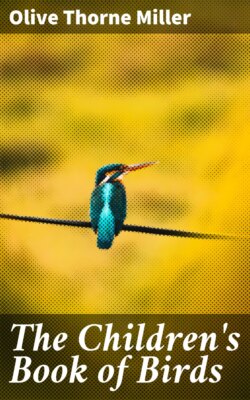Читать книгу The Children's Book of Birds - Olive Thorne Miller - Страница 17
На сайте Литреса книга снята с продажи.
ОглавлениеHIS EDUCATION
The young bird has to be educated, or trained for his life, just as we do, though not exactly in the same way.
He does not have to know arithmetic and history; and what he needs of geography is only the road to the South, where he spends his winters.
I suppose the first thing he learns is to fly. You have heard, perhaps, that the old birds drive their young out of the nest. But do not believe any such thing, for it is not true. I have seen many little birds leave the nest, and almost every one flew when the parents were away after food.
The parents sometimes try to coax a nestling who is afraid to try his wings, like an oriole I knew of. All the young orioles had flown except this one, and he seemed to be too timid to try. He stood on the edge of the nest, and called and cried, but did not use his wings.
The father came to see him now and then, and at last he made him fly in this way. He caught a fine, large moth, and brought it to the nest in his beak. The young bird was very hungry, and when he saw the food, he opened his mouth and fluttered his wings, so eager to get it he could hardly wait.
But the parent did not feed him. He let him see the moth, and then, with a loud call, he flew to the next tree. When the little oriole saw the food going away, he forgot he was afraid, and with a cry of horror he sprang after it; and so, before he knew it, he had flown.
After the young bird can fly, he needs to be taught to get his own living, or to find his own food, and also where to sleep. Then he must learn what to be afraid of, and how to protect himself from his enemies.
He needs to know the different calls and cries of his family, and what they all mean. He has to learn to fly in a flock with other birds, and he must learn to sing. No doubt there are many more lessons for him that we do not know about.
If you watch little birds just out of the nest, you may see them being taught the most useful and important lesson, how to find their food.
The robin mother takes her little one to the ground, and shows him where the worms live and how to get them. The owl mother finds a mouse creeping about in the grass, and teaches the owlets how to pounce upon it, by doing it herself before them.
The old swallow takes her youngsters into the air, and shows them how to catch little flies on the wing; while mother phœbe teaches hers to sit still and watch till a fly comes near, and then fly out and catch it.
If you watch long enough, after a while you may see the old bird, who is training a young one, fly away. She may leave the young one alone on a tree or the ground, and be gone a long time.
Before many minutes the little one will get hungry, and begin to call for food. But by and by, if nobody comes to feed him, he will think to look around for something to eat. Thus he will get his lesson in helping himself.
Once I saw a woodpecker father bring his little one to a fence, close by some raspberry bushes that were full of berries. He fed him two or three berries, to teach him what they were and where they grew, and then quietly slipped away.
When the young bird began to feel hungry he cried out; but nobody came. Then he looked over at the raspberries, and reached out and tried to get hold of one. After trying three or four times, and nearly pitching off his perch, he did reach one. Then how proud he was!
The father stayed away an hour or more, and before he came back that young woodpecker had learned to help himself very well; though the minute his father came, he began to flutter his wings and beg to be fed, as if he were half starved.
A lady, who fed the wild birds on her window sill for many years, and watched their ways, says she often saw the old birds teaching their little ones. They showed them where the food was to be found, and, she says, regularly taught them the art of eating.
Then she saw them taught to be afraid of people, not to come too near her. And once she saw an old bird showing a young one how to gather twigs for nest-building. The young one looked on a while, and then tried hard to do it himself, but could not get off a single twig.
Best of all, the same lady heard an old robin giving a music lesson. The teacher would sing a few notes and then stop, while the pupil tried to copy them. He had a weak, babyish sort of voice, and did not succeed very well at first.
I have heard several birds at their music lessons.
